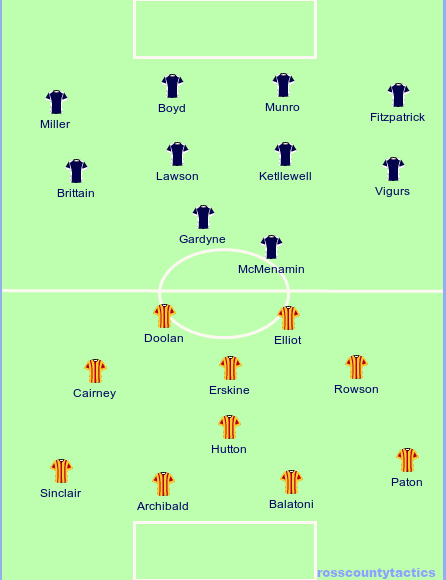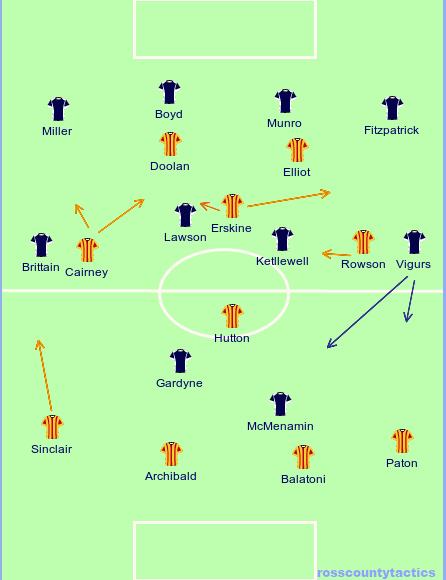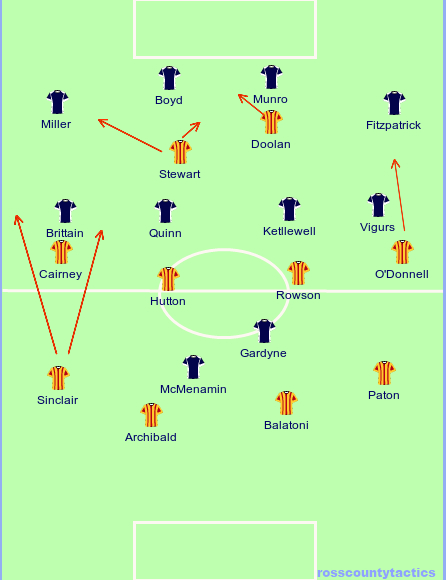A detailed match report can be found on the Jailender website.
You will also find a light-hearted preview and short review of the match on the recent Jags Cast podcast, involving Ross County Tactics, which has now been published.
The use of ‘artist illustrations’ features again this week. The Subbuteo board might return for the next analysis.
INTRO
Ross County extend their run of form to six wins in a row and ten successive matches unbeaten in the league, after deserving the three points against Partick Thistle.
Thistle played on the front foot in this match, but could only test County goal-keeper Michael Fraser once, towards the end of the match. They struggled to get a number of dangerous crosses in, despite getting to the bye-line more than most teams do against County, while their passing in front of goal was on the whole a little predictable. Ross County played in a similar fashion as against Greenock Morton in their previous match, soaking up pressure and threatening on the counter attack, which has turned out to be an efficient strategy away from home in recent weeks.
FORMATIONS


The two starting line-ups, against how they matched up
Thistle started against County with a 4-1-3-2 formation. It wasn’t too far away from the set-up against Ross County in Dingwall in September. The surprise was that perennial danger-man Chris Erskine (at least against Ross County) didn’t start out wide, but behind the two forwards. He was flanked by Paul Cairney and David Rowson, both good footballing midfielders but not natural wingers.
Ross County went for consistency, with the same team that won at home to Hamilton and away to Morton. The 4-4-1-1 formation had Gardyne playing as the supporting forward to McMenamin up front. Rocco Quinn found a place on the bench after recent injury.
LACK OF WINGERS
The main tactical point in the first half was the lack of any natural wingers playing on the wing. Erskine is an exciting, dangerous player and can typically cause a defence problems in any area of the opposition half, but against Ross County he found himself with very little room to play behind the strikers in the first half.
Indeed, it was a surprise for this site that Erskine didn’t start on the wing. It is arguable that the most effective way of breaching this Ross County defence is to attack its full-backs. Thistle perhaps realised this and had Erskine play right-wing from the start of the second half. A little more on this later.
On the other flank, Thistle used Paul Cairney. He is a predominantly right-footed player who wants to get involved in play in the centre of the pitch. Cairney normally is allowed to cut in, due to the athleticism of Aaran Sinclair at left-back, who got forward to attack the bye-line at most opportunities.
Ross County similarly did not play with a natural winger. Marc Corcoran was on the bench and only had a time-killing cameo appearance at the end. Richard Brittain and Iain Vigurs took up the flanks, with both players more natural central midfielders than wingers.
We think that the outcome of the match hinged – to a greater or lesser extent – on the effectiveness of both teams’ left-sided midfielders.
CAIRNEY
Paul Cairney is a quality player, who is stocky, but has a deceptive burst of acceleration. He also has a strong right foot, with a good range of passing. He was not afforded the opportunity to spread the play wide right to Erskine (and then O’Donnell) later in the match, but drove into the box with the ball when he could.

Thistle looked their most enterprising when Cairney combined with Thistle left-back Aaron Sinclair (or Sekhon, if Sky Sports Centre is to be believed). In the first half, Thistle relied on their width from the full-backs. Sinclair on the left was much more threatening than Paton on the right.
However, with Cairney quite often found so narrow to get involved in the match (and Rowson on the other side also tucking in, when Thistle attacked on the right), it left the Thistle full-backs with the job of breaching the County defence on its own. That was not an easy job to do. County’s defenders have performed impressively in recent months. The last goal to be conceded in open play was against Livingston on 17 September.
VIGURS
In our opinion, Iain Vigurs was the most influential player on the pitch, offering a strong out-ball to his defence and combined well the forwards in front of him.

With Ross County generally having a deeper defensive line than Thistle, and at times were relatively happy to defend on the back foot, this gave Vigurs room in front of him to take the ball forward into. McMenamin’s off-the-ball play is consistently excellent and he thrived on the ball over the defence from midfield, particularly from Vigurs.


Vigurs was at the heart of County’s best play and deserved his goal. In this instance, he first of all took the ball out of his team’s defensive third, combined with Gardyne and hit a half-volley into the top-left of Scully’s net. The second illustration here shows Vigurs sitting off of the play. His late runs inwards from the left flank are a constant surprise to teams.
HUTTON

With the two starting formations matching up, Kyle Hutton was often the spare man in the midfield zone, sitting behind the band of three that competed directly against County’s midfield.
Hutton showed his passing range, getting the ball early to the full-backs as early as he could. This picture shows Hutton using the space that Paton found on the flanks, because of how narrow Thistle were and how County were willing to defend narrow. Paton himself didn’t do anything threatening with the ball, which was in contrast to his last match in Dingwall when he was possibly Thistle’s best player. What Hutton probably was not aware of was that his position drew County midfielder Paul Lawson out of position to meet him in this instance, which left a trio of Thistle players with the potential to play in space close to County’s goal.
Hutton rarely wasted a pass in possession, but he looked quite casual off-the-ball compared to the constant pressing of County’s midfield. He could perhaps have done more to collect the ball from his defence at times.
COUNTY IN DEFENCE
Ross County were strong in defence and it took until 80-odd minutes for Doolan to really test Michael Fraser, who pulled of a good save at that point.
Until then, County were helped by Thistle playing narrow in the first half.

This picture shows that Thistle’s formation, with Rowson drawing Marc Fitzpatrick out of position from alongside the rest of the back four. Erskine, circled in yellow, could have moved into the vacant position. If he received the ball in that second yellow circle, County’s defence might have been exposed.
It is also worth noting from that picture how close Kettlewell and Lawson played together at times. Lawson was substituted for Rocco Quinn on 42 minutes, because he was already on a yellow card and had committed a number of small, incidental fouls that might have accumulated into a further yellow card. Up until that substitution, Lawson and Kettlewell kept County’s centre-backs well protected in open play. There was little sense in playing Erskine in that area, which brought about his move to the right wing in the second half.

This other picture shows how well Ross County defended in open play. Kris Doolan, joint top scorer in the First Division last season, resorted to speculative shots under pressure. Michael Fraser didn’t have a save to make in the first half.
SECOND HALF CHANGES
Partick Thistle manager Jackie MacNamara made a slight change in the second half, swapping Erskine around with Rowson and reverting to what looked like a flat 4-4-2. This allowed Rowson to make runs from deep, when otherwise he would partner Hutton in the centre of midfield. More importantly, at least in theory, this allowed Erskine to get a run at Fitzpatrick in the County left-back position.

Thistle tried to use the full width of the pitch. Cairney started wide and would attack the box late, while Thistle left-back Sinclair would either over-lap on the outside or cut in and attack the bye-line closer to the dimensions of the 18 yard box.
However, on the other side, Erskine never got to attack Fitzpatrick anywhere as much as he would have hoped. Hutton was no longer the spare man in midfield, as he and Rowson were matched by Quinn and Kettlewell. Hutton therefore never found the space that he was accustomed to in the first half, when he was able to spread the ball to the right wing early.
Another reason for Erskine’s lack of impact was that Cairney, as already explained, started wide left. Cairney was simply never in much of a position to switch the play to the other flank. Erskine cut a frustrated figure on the right wing. Erskine potentially had the space in front of him to dribble in to, but never got the service he needed to make a nuisance of himself.

Formations after 66 minutes.
With two thirds of the match gone, Thistle made a double substitution, bringing on young winger O’Donnell and deep lying forward Stewart. Stewart looked dangerous, because his movement took him to the left flank, where he could combine with Cairney/Sinclair and over-load County’s right-back. His position at times made Thistle’s shape look like a 4-3-3, with O’Donnell hugging the right touch-line and Doolan ready to pounce in the middle. Stewart got one good cross in to Doolan, who couldn’t get any power on the header and Fraser saved comforotably.

Ross County’s defensive shape, on the flipside, was compact while they sat deep. Their centre-forward McMenamin used the channels well to hold the ball up for on-coming midfielders. County missed a number of chances to increase their lead. McMenamin himself probably ought to have scored on a one-on-one situation against Scully in the first half and was unlucky in heading on to the cross-bar early on.

Towards the end of the match, right-midfielder Brittain tucked inside and Quinn went on the right flank, so that Brittain’s grit could be used to defend against Thistle’s attacking phases. On the counter attack, County could commit their wide players forward, in support of Gardyne and McMenamin. Among the four of them they kept the ball well, high up the pitch.
CONCLUSION
Partick Thistle will be frustrated to not have made more clear-cut chances in front of County’s goal. When changing to a flat 4-4-2 seemed to be the solution to beating County from watching the first half, losing the spare man in central midfield meant that Thistle couldn’t get enough quality service to their wide players. Thistle found themselves against a stubborn, at times stifling defence.
Ross County have now played and won two tricky away fixtures in succession, without conceding a goal, which is partly down to the organisation in defence and also due to their counter-attacking ability.
Falkirk at home next week presents a different challenge, where County will be looking to play on the front foot and take the game to Falkirk. It will be a fascinating top-of-the-table contest.
Unfortunately, this site will not be covering the Falkirk match. The next report will probably be Albion Rovers’ visit to Dingwall on 19 November, failing which it will be the home fixture against Raith Rovers on 3 December 2011.

Very good and fair analysis of what indeed was a frustrating game for us Thistle fans.
Thank-you for the feedback!
Pingback: Dundee 1 – 1 Ross County 25/02/12 | rosscountytactics.com